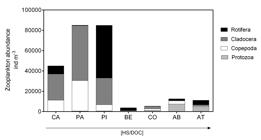Abstract
Aquatic humic substances (HS) represent about 60-95% of the dissolved organic carbon (DOC) present in coastal environments of northern Rio de Janeiro state, Brazil. Although they are important regulators of processes involving aquatic communities, the response of the zooplankton community to their presence remains poorly understood, especially in natural tropical environments. Therefore, our objective was to elucidate zooplankton community responses along a natural gradient of HS. Such natural humic gradient was obtained in coastal freshwater environments with distinct DOC concentrations (20-200 mg L-1). Results show a decrease in zooplankton density and biomass along the HS gradient. However, microphages organisms (e.g. non-predatory rotifers and smaller testate amoeba, such as Difflugia) were most present in environments with higher concentration of HS, probably due to a stronger importance of the microbial-loop in these environments. Some species – such as Scapholeberis armata (Cladocera) and Lecane boettgeri (Rotifera) were only accounted for environments with high HS concentration, illustrating their potential as bioindicators for HS presence. Nevertheless, we were able to observe the effects of HS on the structure and composition of primary consumers and how these substances might indirectly affect species dynamics. We point out to new findings in highly humic tropical environments, which are still poorly studied and understood.
Key words
Blackwater; dissolved organic carbon; plankton; primary consumers

 Thumbnail
Thumbnail
 Thumbnail
Thumbnail
 Thumbnail
Thumbnail
 Thumbnail
Thumbnail
 Thumbnail
Thumbnail




